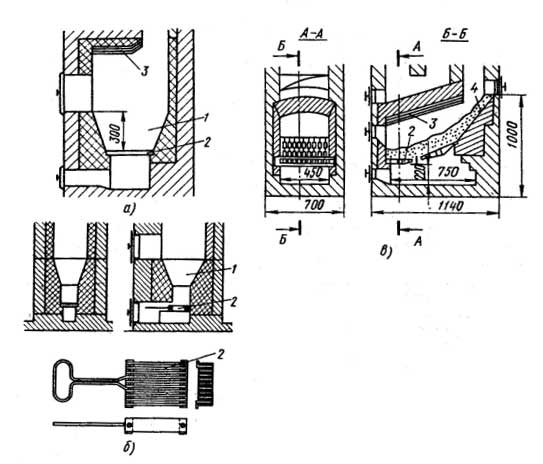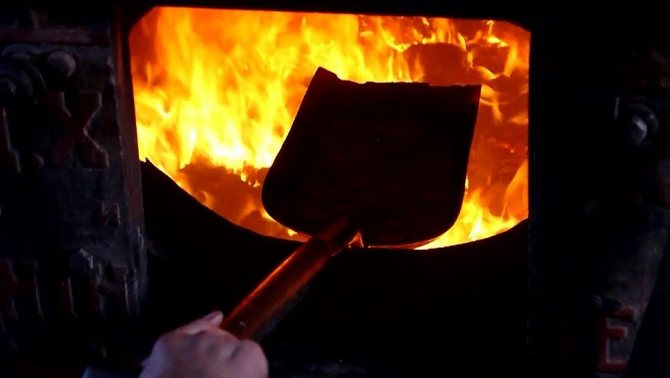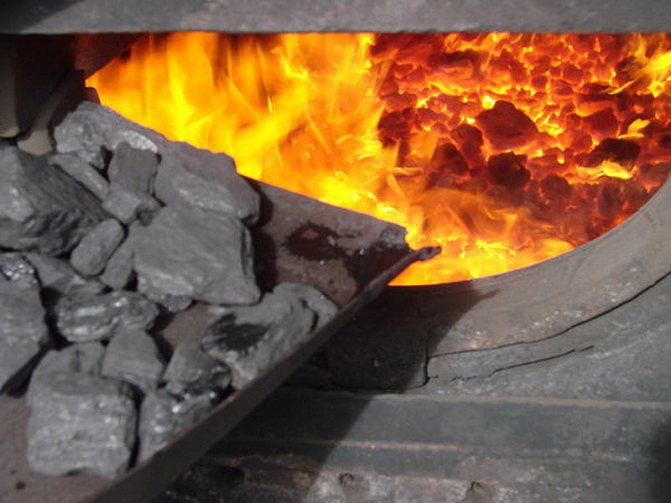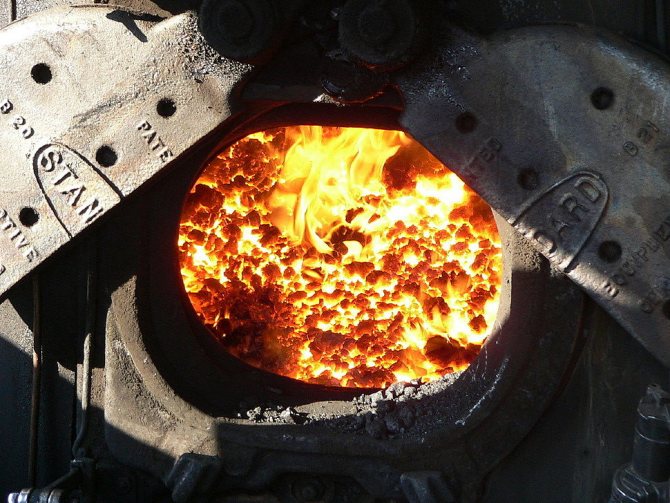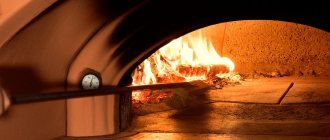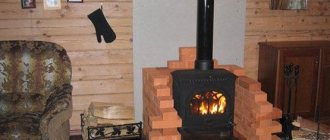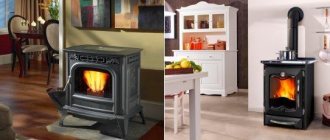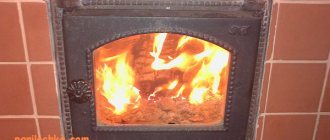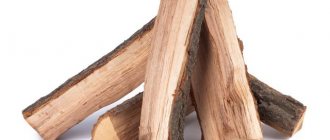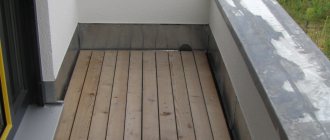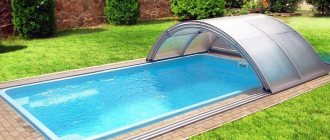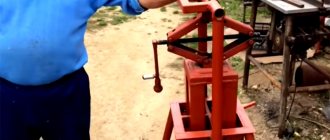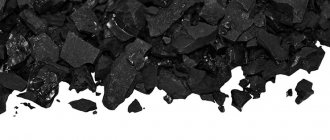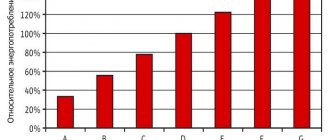Features of the design of coal furnaces
If you look closely at a coal stove and its most common competitor, a wood-fired one, then, in principle, it will be difficult to find special differences at first glance. But with a closer examination and familiarization with the principle of operation of the furnace itself, it becomes clear that they differ fundamentally. (See also: Do-it-yourself stove housekeeper)
- The principle of combustion and air supply differs, if for wood-burning stoves the most efficient combustion can be achieved when air is supplied directly to the place of fuel combustion from above, then for coal stoves it is necessary to purge the fuel and supply the air mixture from below.
For wood-burning stoves, the use of dry fuel in the heating process is not particularly critical. It is only important that the initial kindling of the furnace occurs with dry material. It is advisable to preheat coal before adding it to the crucible in a special section of the furnace, which is heated by exhaust gases.
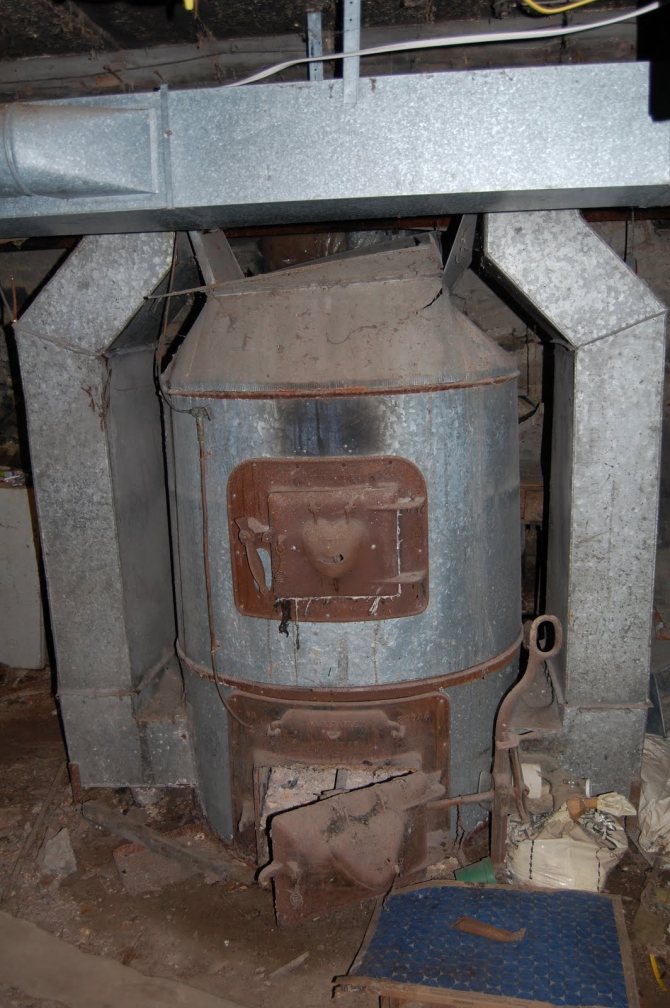
The design of the chimney for a coal stove differs slightly from wood-burning counterparts and is designed for a higher air flow rate. And the flow itself and its speed are regulated not with a yushka, but with the help of a blower. The very same damper that blocks the chimney (yushka) is completely absent. This feature is due to the fact that coal stoves smolder for a very long time, and do not quickly burn fuel like wood-burning ones. The disadvantages of coal stoves are also associated with this feature:
- it is impossible to block the chimney by preventing, the weathering of heat will be poisoned by carbon monoxide because of the danger, and therefore coal heating stoves cool down rather quickly.
- For normal combustion of a coal furnace in its lower compartment, it is desirable to exclude the presence of combustion products. To do this, it is necessary to periodically clean the ashtray, which will be constantly replenished with burnt coal. In this case, cleaning should occur more often than is necessary for a wood-burning stove.
The walls of coal stoves must withstand a higher temperature than ordinary wood stoves, respectively, they will be thicker, and more heat-resistant materials must be used for their assembly.
(See also: DIY camping stove)
A coal stove may have a special design for loading fuel, this is due to a higher ignition temperature of coal - that is, it will not be possible to flood such a stove with just a piece of newspaper and matches. Therefore, in a coal stove, firewood is first kindled, and coal is loaded from above, which gradually flares up as the wood burns out.
In practice, combined furnaces are often used, in which both coal and wood can be burned at the same time. In addition, the fuel can also be used as a fuel peat briquette, which is very similar in combustion to coal. In combined devices, all elements of both coal and wood stoves are simultaneously present.
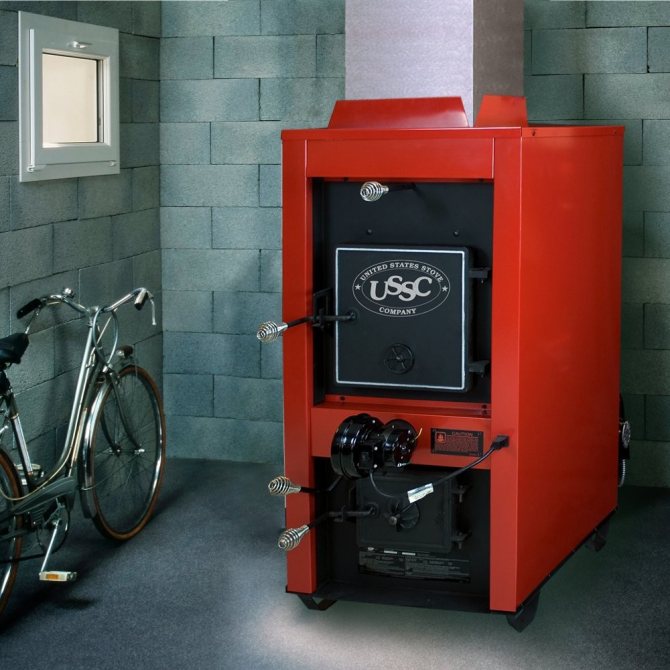

Nuances of burning coal stoves in winter
In winter, at low temperatures, it can be difficult to light the stove. In addition, the special draft, which is formed due to cold air, does not allow smoke to escape freely. There is no way to quickly ignite the stove. You can improve the kindling process with a hair dryer, which heats up the inside of the heating equipment.
Such heating of the furnace device will avoid smoke, which is typical for cold structures. The oven should be warmed up in winter several times a day so that the system does not have time to cool down too much.
Coal is considered the most efficient fuel.It is successfully used for kindling furnaces. The level of heat transfer of such raw materials is higher than that of wood raw materials. A good result of using coal for the stove can be obtained only by observing all the rules for kindling and operating the heating device.
The effectiveness of coal as an economical fuel for a private house has been proven in practice. This mineral has been successfully heating our homes for several centuries. Recently, its popularity has dropped somewhat.
This is due to the widespread distribution of gas heating. Where the gas pipe has not yet reached, coal is still used with success. How to make charcoal stoves for your home with your own hands? How to choose a ready-made option? The answers to these questions are below ...
Coal
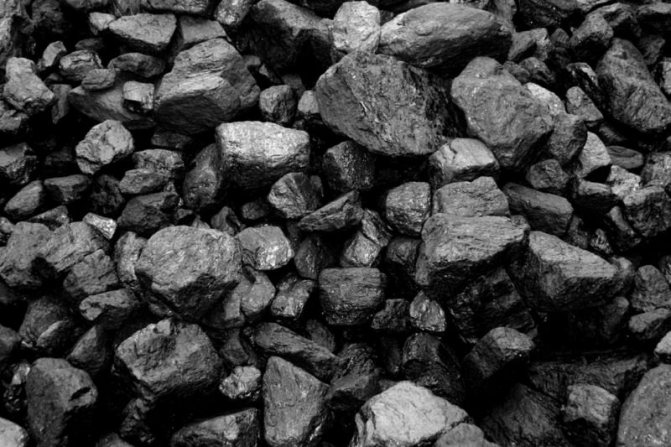

Coal is a traditional raw material for solid fuel boilers. It burns for a long time and has good heat dissipation, but only if it is correctly laid in the furnace chamber, competent ignition and subsequent support.
Coal selection
To increase the boiler efficiency and extend its service life, it is necessary to take into account the manufacturer's recommendations for choosing a coal grade. Usually the brand name and its fraction are indicated in the technical passport of the device. Each of the brands has a different ratio of carbon and impurities, different moisture content, structure, strength and age of formation.
The most popular types of coal for solid fuel boilers:
- Coal. The heat transfer of the fuel is 5500 kcal / kg. The average percentage of carbon and ash is 75% / 3%. Suitable for lighting most classic boiler models.
- Anthracite. Specific heat indicators - 9000 kcal / hour. The percentage of carbon is no more than 7%. The disadvantage of the variety is the difficulty in firing up and the extremely high combustion temperature.
The most demanded and convenient for ignition is hard coal of the long-flame category. This universal fuel for all types of boilers ignites quickly, burns for a long time and gives off a large amount of energy.
You can find brown coal and lingitis on sale. However, these grades are only recommended for commercial use due to their high ash content and high humidity levels.
How to heat a boiler with coal
The solid fuel plant consists of two main chambers: the upper one is used for stowing fuel, and the lower one (ash pan) is used for collecting ash and slag. As the fuel burns in the main chamber, the combustion products gradually fall into the ash pan, from where they are removed manually.
Before starting melting, it is necessary to prepare the installation for operation. For this, solid combustion products are removed from the ash pan, the walls of the combustion chamber are wiped and the chimney channels are cleaned.
As soon as the preparatory work is completed, you can start loading fuel and igniting.
- Place dry paper on the grate of the main chamber. It is recommended to pre-crumple it - this way it will ignite faster.
- On top, evenly lay the chips, brushwood - in the form of a well or a hut.
- Light a match and bring it to the paper from different sides - the paper will evenly flare up, involving chips in the process.
- Close the firebox door, open the ash pan flap for oxygen supply. At this stage, you will have to monitor the combustion process of the chips. The intensity can be adjusted using the ash pan (blower) door.
- As soon as the chips have completely ignited, pour a small layer of fine coal on top of it. Its amount should not exceed a third of the combustion chamber.
- After loading the first batch of coal, close the door again to reach the maximum combustion temperature. This usually takes about
- When the first layer of fuel completely engulfs the flame, add the remaining coal to the upper border of the door. Beforehand, it is recommended to slightly stir the burning coal.
- Close the blower door halfway. If there is strong smoke, leave a small crack.
As the combustion progresses, fuel is added in small portions to the main chamber, each time closing the ash pan flap. Do not put a large amount of coal at once - this will lead to solidification of the fuel on the grate and its premature deterioration.
Firewood
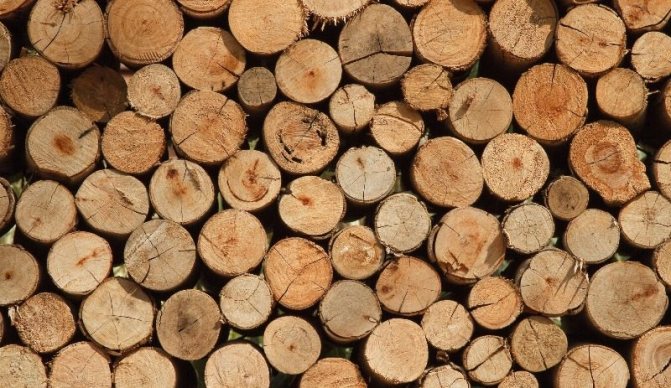

Firewood is another popular type of boiler fuel. Only dried wood is suitable for burning. Underdried firewood in the firebox begins to release moisture, which accumulates on the inner surfaces of the firebox and chimney. In combination with smoke and carbon monoxide, tar is formed - it reduces the operational properties of the boiler and reduces the permeability of the exhaust gases.
Choosing firewood
For melting, hard wood with a long burning period and slow heat transfer is optimal. Deciduous trees should be preferred over conifers. In the process of combustion, conifers emit a large amount of resinous substances, quickly contaminate the combustion chamber and heat exchanger.
According to the degree of hardness, wood species are divided into 3 categories:
- hard - white acacia, ash, beech, oak, maple, yew, hazel, pear;
- medium hardness - walnut, alder, sycamore, birch, cherry, sweet cherry, cedar;
- soft - poplar, aspen.
How to heat a boiler with wood
- At the first stage, it is necessary to warm up the heating device well. This will prevent smoke from leaking into the room. Sheets of paper are laid at the bottom of the fuel chamber, on them are flammable birch bark, chips and splinters, and on top are small logs (up to 15 cm in diameter). The space between the wood chips can be filled with paper for faster ignition.
- When the firebox is about half full, you should set fire to the paper and open the ash pan valve for better draft. Close the main chamber door.
- When the chamber and chimney are warmed up, and the preparatory bookmark starts to burn out, the firebox can be filled with large firewood. Logs can be laid out in a row or in the form of a well, leaving gaps between them for air penetration.
- As the wood burns out, you will need to make a new bookmark, without waiting for the previous one to fade.
Long-burning boilers greatly simplify the work. The fuel is loaded in them every 6 hours due to the automatic regulation of the draft and the combustion process. Such devices should be melted in accordance with the attached instructions.
Principle of operation
The principle of operation of a coal stove is not much different from a wood-burning stove. This is a very common misconception. Heating coal and wood-burning stoves differ radically. And here's what:
- For the combustion of coal, air must be supplied from below.
- Coal requires preheating before being sent to the furnace. Raw coal simply won't burn.
- The chimney should provide a faster passage of air than in a wood-burning stove. With this design, the damper is completely absent. The air supply is regulated from below, through the blower.
The burning process of coal takes much longer. Coal does not burn quickly like wood, but smolders for a long time. The combustion temperature is higher, which places special demands on the materials for the manufacture of the furnace. We will talk about this later.
Speaking about the process of burning coal, it is worth paying attention to one feature. If firewood in the process of pyrolysis easily decomposes into coke and gases, which have a high temperature and heat transfer, then coal burns differently. On the surface, it will have the highest temperature, and the temperature of the outgoing gases will be much lower.
How to calculate coal consumption
The consumption of coal in a solid fuel boiler depends on many factors. Costs are affected by:
- Heated area.
- The amount of heat loss.
- Ambient temperature.
The exact costs can be calculated only after the end of the heating season. Moreover, depending on the winter, the average consumption of coal for heating can vary from 8 to 15 tons (for a building of 200 m²).
If you make averaged calculations based on real operating experience, you can get the following data:
- Costs for September - October will amount to 1 bucket per day.
- Fuel consumption rates in a coal boiler from November to February will increase to 10 buckets per day.
- In March and April, you will need to burn 1-2 buckets per day.
Calculation of the coal consumption for a boiler of 20 kW, using the above data, will show that the costs during the heating season will amount to 580 buckets or 10-10.5 tons.
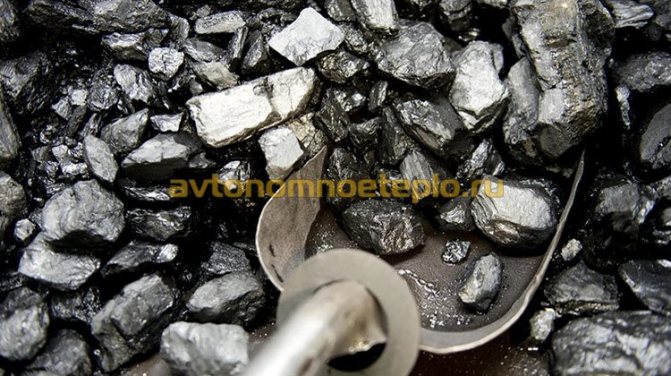

How to choose for a home and selection criteria?
To choose the right stove, you need to consider the following:
- The design is factory-made or made by hand. Below are detailed instructions for both options.
- Determined by the type of oven (see the corresponding section).
- Select the required parameters.Let us dwell on this point in more detail. In order for the oven to live up to expectations, you need to consider the following:
- Choose the right power. With factory devices, everything is simple - manufacturers indicate in the passport the power and cubic capacity for which the furnace is designed. It is necessary to try to ensure that the volume that needs to be heated was somewhere in the middle of the specified range. This will provide the necessary margin in case of possible heat loss. With a homemade stove, not everything is so simple. You will have to perform the calculation yourself, according to the formula:
P = (M-Bridge) * Cn / T / 1000, where
P is the required power, kW
M is the weight of the fuel used, kg
MOST is the mass of the remainder of the burnt fuel (i.e., what remains after the active phase of combustion), kg
Cn - thermal conductivity of coal, J / kg
How to do it yourself
- The design of a brick oven fired with coal or briquettes is quite simple, you just need to comply with two conditions:
the firebox must be made of refractory bricks; the stove must be equipped with cleanings in all parts of the chimney.
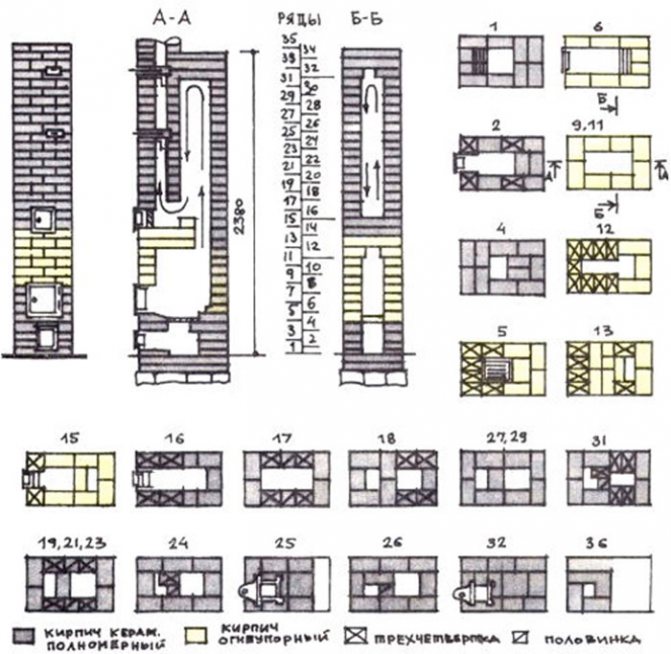

The ordering diagram of the universal furnace is shown in the figure. Thanks to a simple device, you can do it yourself, even without experience. The stove has a small size, it can be used to heat a country or country house with an area of up to 36 square meters, consisting of one or two rooms. In the latter case, the firebox is placed on the side of the kitchen, and the back wall, which heats up during the firebox, is taken out into the room.
The furnace consists of a do-it-yourself fireclay made of refractory fireclay bricks, and a supra-furnace channel with one roll-up.
The flue gases are retained in the duct, a bell effect is created, and the furnace body heats up. After cooling down, the smoke descends and through the curtain goes into the chimney. It is equipped with two dampers, eliminating the sharp boundary between warm and cold air and moisture condensation.
Below the firebox there is a blower combined with an ash pan. Pressurization is carried out through the grate, air movement is ensured by a simple chimney design and good draft.
- Install the oven on a freestanding reinforced concrete foundation. The dimensions of the foundation should exceed the dimensions of the furnace by 5-10 cm, its height is 50-70 cm, while it should be 15 cm below the level of the final floor covering. After pouring and drying the foundation, it is leveled with cement mortar, two layers of roofing material or other rolled waterproofing are laid on it, after which they begin laying the furnace with their own hands.
- They lay out two rows of bricks - the base of the furnace, with solid masonry with a red brick bandage. They are placed on a cement mortar.
- Further, the laying is carried out in accordance with the scheme for a solution of chamotte clay. The first row forms the bottom of the ash pan.
- In the second and third rows, the blower door is exposed, securing it with the help of annealed wire laid between the bricks.
- The fourth row forms the overlap of the ash chamber and an opening for a blower and ash removal from the furnace.
- Starting from the fifth row, the masonry is carried out with fireclay bricks.In the fifth row, a grate is laid.
- In the sixth and seventh, the firebox door is installed similarly to the blower door.
- Rows 9 to 11 form the walls of the furnace, they are laid with a bandage.
- In the 12th row, a vault is made of ¾ part of the brick, and in the 13th and 14th, they overlap the vault.
- In the 15th row, a cleaning door and a roll-up are installed.
- Starting from the 16th row, the masonry is again made of red brick. Smoke channels are laid out according to the scheme.
- Valves are installed in the 25th and 32nd rows.
- Rows 33 and 34 complete the stove overlap, then lay out the chimney of the desired height.
- The stove is dried in air, then it is carefully heated in multiple stages, first with wood, and after several furnaces with coal. During operation, it is allowed to use any solid fuel: coal, anthracite, firewood and wood waste, pellets and briquettes.
Any metal stove with the effect of long burning can be adapted for burning coal. having laid out a fireclay brick lining in the firebox with their own hands and equipped the blower with a fan. With such a modification, the furnace metal will not burn out from high temperatures, and the coal will burn steadily for a long time.
Design of fireboxes for different types of fuel
General information. The firebox designed for fuel combustion must be designed so that the best conditions for the development of the combustion process are created: a high temperature is maintained in the combustion zone; a uniform and sufficient supply of air to the burning fuel was ensured; contained the required amount of fuel (solid).
To create these conditions, the firebox is given certain dimensions, and when solid fuel is used, a grate is placed in its hearth, which is placed 70 ... 140 mm below the firebox door so that when the door is opened, burning coals do not fall to the floor. In some cases, vaults are made that partially reflect radiant heat onto the burning fuel. During the combustion, it is sometimes necessary to adjust the thrust force in the furnace, since the size of the thrust force determines the intensity of the fuel combustion process. The draft is usually regulated by a blower door and a smoke damper, setting them in a certain position.
The dimensions of the firebox are determined from the condition of simultaneous loading into it of the Total amount of fuel required for one firebox, or at least 75% of this amount. The dimensions of the firebox for different types of fuel are determined by calculation. The length and width of the fireboxes of brick stoves should be a multiple of the dimensions of the brick or half-brick. The width of the firebox is taken depending on the heat transfer of the stove. In furnaces with a heat transfer of up to 3489 W, it can be from 190 to 270 mm, in furnaces with a heat transfer of more than 3489 W - 270 mm and more. In furnaces in which low-grade coals are burned, it is allowed to make fireboxes up to 500 mm wide. The height of the firebox is chosen depending on the given heat transfer of the stove, as well as the mercury type of the fuel. In accordance with this, fireboxes are usually made with a height of 400 to 770 mm and more, but not more than 1000 mm. In some cases, deviations from this rule are allowed, for example, when the volume of the firebox passes into the fire channel.
The minimum thickness of the outer walls of the firebox is 1/2 brick (120 mm). In furnaces with a heat transfer of more than - 3489 W, the thickness of the outer walls of the firebox can be brick and whole brick, depending on the heat transfer of the furnace. Furnace fireboxes are lined with refractory or refractory bricks. The lining is a 1/2 brick protective lining of the inner surface of the firebox, which protects the walls and roof of the furnace from the destructive effects of high temperatures. If the heat transfer of the furnace for any type of fuel does not exceed 3489 W, then the lining is made 1/4 brick thick. The cladding is performed provided that the refractory bricks are firmly secured without ligation with the main masonry. the outer walls of the furnace are made of ceramic bricks.In the absence of refractory bricks, the fireboxes are lined with selected ceramic bricks, although such a lining is short-lived.
| Fig. 8. Firebox for burning firewood: 1 - blower door, 2 - furnace door, 3 - kolosinkooan grate, 4 - vault. |
Fireboxes for solid fuel (firebox for firewood of Professor V.M. Chaplin). Firewood stove (fig. 

The air for fuel combustion enters the firebox through the blower door 1 (door 2 must be closed during the combustion). Passing through the gaps in the grate 3, the air evenly washes the rows of firewood lying on the grate, which contributes to the completeness of combustion. The vault 4 of the firebox reflects the radiant heat of the burning fuel onto the wood, which also favors the combustion process. The air supply to the firebox is self-regulating to a certain extent.
at the beginning of the firebox, while the wood is not charred and the fuel layer still has significant resistance to the air flow, its passage is facilitated by the fact that the grate is not tightly covered with wood (the logs rest their ends on the staples of the firebox shaft). As the fuel becomes charred, the grate gradually begins to close by the coals rolling onto it, and the access of air to the firebox becomes more and more difficult.
By the end of the firebox, only a layer of coal remains in the firebox, tightly closing the gaps in the grate. During this period, the combustion chamber requires less combustion air. Thus, the grate, the blower door and the side brackets of the firebox largely regulate the air flow depending on the combustion process.
Firebox for peat and dung. Peat with normal moisture content (25 ... 30%) burns well in fireboxes equipped with a grate. To burn wetter peat and dung, use the firebox shown in Fig. nine.
in this firebox there are two grates - horizontal 1 and inclined 2. When the furnace is fired, a small amount of the driest peat is thrown onto the horizontal grate and a fire is made.
| Fig. 9. Firebox for peat and dung: 1 - horizontal grate, 2 - inclined grate, 3 - holes. |
When the first portion has ignited, the firebox is loaded with peat in such a way as to close the inclined grate with it. Combustion first takes place in the lower dried layers of peat. As the upper layers dry out, the combustion gradually spreads upward. The evaporated moisture and flue gases are removed through two holes 3 in the rear wall of the firebox.
in treeless areas, where there is neither coal nor peat, dung is used to heat the stoves. Due to the similarity of dung to peat, it can be burned in peat fireboxes. The grates of the fireboxes, in which peat and dung are burned, must have gaps of no more than 8 ... 10 mm so that small particles of peat and dung cannot spill through them.
Fuel boxes for coal and anthracite. Coal of all types and grades should be burned in fireboxes equipped with a grate and providing enhanced air supply to the combustion zone.
The firebox of the simplest device for burning coal (Fig. 10, a) has a shallow shaft 1 with a grate 2 and a reflective roof 3.
The firebox of a more advanced design (Fig. 10, b) is adapted for burning anthracite. The shallow shaft 1 and the retractable grate 2 of the firebox make it possible to remove the accumulated slag during the furnace. The grille is made up of steel: plates, between which gaskets are clamped.The latter keep the plates at a certain distance from one another, due to which gaps remain between them. The height of the plates is at least 40 mm, so the air going from the ash pan to the fuel cools the grate, as a result of which it lasts longer.
Slag accumulating on the grate during the furnace firing is removed with a steel hook 5 ... 6 mm thick through the slots on top of the grate.
|
| Fig. 10 Fuel tanks a - for coal, b - for anthracite, c - for ash coal and shale; 1 - shaft, 2 grate; 3 - arch, 4 - inclined under. |
Firebox for ash coal and oil shale. The design feature of the firebox for burning multi-ash coal and shale (Fig. 10, c) is a long inclined hearth 4, turning into a horizontal grate 2. The inclined hearth in combination with a deflective roof 3 contributes to the creation of a high temperature in the firebox, which is necessary for burning wet and multi-ash coal. The stove is melted by kindling finely chopped firewood on a horizontal grate. The coal loaded into the firebox is for the first time on an inclined hearth, where it is dried. Gradually, the coal slides down and flares up.
Fuel boxes for gas.
The design of the fireboxes for gas is basically the same as for firewood or coal. Fuel tanks are equipped with special burners.
A gas burner device designed for heating furnaces must meet the following requirements:
ensure a stable combustion process with permissible fluctuations in gas pressure in the network and a change in its calorific value; a burner that does not provide stable combustion is prohibited from operating due to the danger of an explosive mixture in the furnace;
eliminate heat losses from chemical underburning in the presence of small excess air in the furnace space; this condition is important not only to achieve a high efficiency of the furnace, but also to obtain a harmless mixture of exhaust gases that would not affect human health;
create a combustion center that would provide intensive, but at the same time, uniform heating of the walls of the firebox along its perimeter.
The uniformity of heating the walls of the firebox around the perimeter of the furnace affects the increase in its service life. So, when converting existing furnaces to gas with burners having a short flame, high local thermal stresses are created near the furnace door. At the same time, the end part of the firebox remains slightly heated. As a result, the masonry of the front wall of the firebox is often destroyed. Therefore, it is important that the walls of the firebox, usually located in the lower part of the stove, heat up more intensively than in the upper and middle zones of the stove. The better the walls of the stove firebox are heated, the more uniform the temperature becomes along the height of the heated room.
The grate, which serves to supply air when burning solid fuel, turns out to be superfluous, since air is supplied through the burner or special holes in the masonry.
"Previous table of contents next"
Homemade stove potbelly stove
Recently, many designers have been offering exclusive options for stoves or fireplace stoves, which are installed in country houses. For residents of prestigious cottages, they are not only an additional source of heat, but also the most beautiful accessory for the interior decoration of the premises. Such individual stoves fill the room with both warmth and special coziness. The firewood crackling in the stove or fireplace looks very beautiful and romantic when a winter blizzard is raging outside the window.
The most popular, primitive and efficient long-burning stove for temporary heating is the well-known potbelly stove. Its simple device is based on the "symbiosis" of the Russian stove and fireplace. With one load of fuel, it is able to maintain a comfortable indoor temperature for 4 hours.The potbelly stove can be installed in any space where the chimney can be brought out.
Today, everyone who has the skills to perform locksmith work can make a potbelly stove with their own hands from all kinds of scrap materials. This oven:
- Does not depend on electricity and gas.
- Easy to maintain and operate.
- Allows you to control the combustion process.
- Takes up little space.
- Compact and economical.
- May have a hole for placing utensils to cook food or heat water.
Among the disadvantages of such a furnace, it should be noted a low efficiency, a high rate of exhaust gases and rapid cooling. Therefore, to maintain the temperature in the room, it must be heated constantly.
As fuel for the stove, you can use:
Materials and equipment for independent work
Our craftsmen make stoves-stoves, having at hand a welding machine and used ones:
- large cans;
- metal corners;
- wide pipes;
- gas cylinders;
- metal boxes;
- large fire extinguishers;
- old barrels;
- steel sheets;
- chimney pipes;
- metal grates.
For the convenience of work, you can also use the technical fittings of factory production in the form of:
The main elements of the combustion unit
Detailed drawings are not needed to make a potbelly stove. The main thing is to get the most efficient design. Consider the main nodes that make up the homemade stove structure.
Combustion chamber
It is the combustion chamber that performs the function of heat transfer. The larger the area of its outer surface, the better.
It is important that the bottom of the chamber has sufficient area for storing firewood or filling coal there. Therefore, cylindrical home-made devices are placed on their side
Rectangular ovens are designed horizontally with a minimum dimensions of 250 × 350 mm.
Oversized stoves from barrels or gas cylinders are practical also in an upright position.
Finished product type
The ash pan, additionally welded or screwed to the bottom of the structure, is convenient for choosing ash. Its arrangement with a blower promotes better heat generation, and the lower door provides the required amount of oxygen and regulation of the combustion intensity.
Doors and openings
These elements are made with their own hands from the remnants of metal after cutting out the openings. After all, scraps from balloons repeat the bend of the surface, and this is very important in work. Steel door hinges are attached to the body by welding, and then the doors themselves are hung on them.
Here it is imperative to provide a locking device, which can be made like a guillotine valve or bolt.
The optimal openings for the firebox are 250 × 250 mm, for the blower - 100 mm high and 250 mm wide. The awnings are installed on the same vertical axis. A distance of approximately 10 centimeters is maintained between the openings. To prevent coals from falling out through the door, the opening of the furnace is placed slightly above the level of the grate.
A steel pipe with a diameter of 100–150 mm is used to remove flue gases in a stove. The pipe itself is not insulated - it serves as an additional source of heat. And for better heat transfer, it is placed at the outlet with inclined or horizontal sections, thereby increasing the path of warm gases.
The outlet for connecting the chimney is placed on top or better on the side. The latter option slows down the evacuation of gases, leaving room for the cooking zone.
Note! In the chimney, to regulate the intensity of the removal of hot gases, it is advisable to use a rotary or directional valve
Diy charcoal stove
It is the cheapest way to make a brick heating stove on coal with your own hands.
Materials (edit)
- brick;
- ready-made mortar for laying ovens;
- cast iron grate;
- cast iron cooking stove;
- metal sheet b = 4mm - 600x1200 mm - 0.72 m 2;
- welding electrodes - 1 pack.
Tools
- trowel;
- trowels;
- hammers;
- drill;
- other.
Scheme and order
Photo №1 General view
Photo # 2 Poryadovka
Description of masonry
- On top, without mortar, put a brick (see photo # 2, first row). We strictly control horizontality using a level.
- Install the blower door. We fix it with a wire and wrap it with an asbestos cord.
- We put grates directly above the blower.
- We continue laying in accordance with the order (see photo No. 2)
- Install the firebox door. We fix it with wire and bricks.
- From above, the row should overlap the fire door and end 130 mm above it.
- We continue laying, slightly shifting the bricks back. Before that, we lay an asbestos cord, on which we will install the hob.
- Let's start forming the chimney from the next row. The design provides for the installation of a shell pipe made of sheet metal or corrugated aluminum. The pipe should not be heavy. Otherwise, the center of gravity may shift.
- On the eleventh row, we put a valve to regulate the air flow. Do not forget to seal it with an asbestos cord and cover it with clay.
- Next, we put the chimney in the quadruple, which we join with the metal one. The pipe should be strictly vertical and not bend to the side. For greater stability, it should be covered with three rows of bricks.
- We remove the knockout bricks that we put on the 4th row, we clean the chimney from debris.
- Now the coal stove should be whitewashed. Any lime will go. Experts recommend adding blue and a little milk. So the whitewash will not darken and fly off.
- We install a metal sheet in front of the firebox.
- Install the skirting board
Do-it-yourself coal stove is not easy. It is better to seek help from an experienced stove-maker or be patient.
Modern charcoal stoves for home description, types
A charcoal stove for home has a lot of advantages. The main ones among them are ease of operation and maintenance, the possibility of using another type of solid fuel instead of coal, and a large heat capacity. And besides, such a coal-fired stove for a country house can be made of different materials.
A coal-fired stove has high efficiency rates (about 60 percent, which corresponds to boilers for heating systems that use liquid fuel). Modern models allow you to control the combustion of coal in the furnace, regulate this process for a more rational use of fuel and heat.
Modern coal-fired stoves are of several types, depending on their purpose:
- heating stoves;
- heating and cooking ovens;
- household;
- fireplace stoves.
Modern furnaces are produced from different materials: refractory bricks, cast iron, steel, talc magnesite, etc.
Coal and its types
At first glance, all coals are the same. But this is far from the case. Coal contains carbon and some non-combustible impurities. As a result of the combustion of these substances, a lot of heat is released and ash is formed.
Coal with different amounts of impurities is mined in different regions. Fuels are determined by specific criteria. Thus, depending on age, the presence of moisture and impurities, as well as the specific heat of combustion, they are distinguished:
- coal-lignite, which is characterized by a loose structure. It is used less in everyday life, and is more often used to ensure the functioning of power plants and other large enterprises. It refers to young coals (specific heat of combustion (CCC) less than 3 thousand kcal / kg);
- brown coal, which is also called subbitominous coal or black lignite. It is, as it were, a transitional phase between lignite and coal. It is usually used in small or private boiler rooms. It is a good quality raw material for the chemical industry (TCF from 3.1 to 5.1 thousand kcal / kg);
- coal, which is a solid, combustible, mineral, occupying an intermediate position between the brown analogue of coal and anthracite (TCF from 5 to 5.6 thousand kcal / kg);

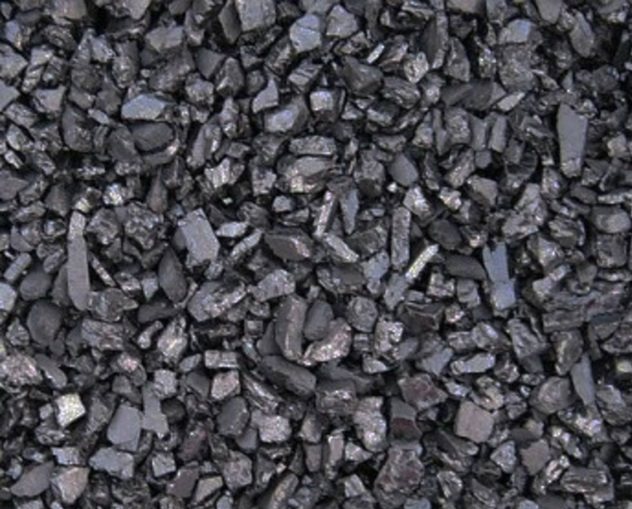
- anthracite is the oldest and best of all varieties, which is characterized by black color, shine, high specific heat of combustion (from 7 to 9 thousand kcal / kg). Premises heated with anthracite are incredibly warm and cozy.
Is it possible to heat with coal
Many owners of houses with stove heating are wondering: is it possible to use coal instead of firewood in a brick stove? Will it burn as efficiently as in industrial boilers?
The process of coal combustion occurs with the release of a large amount of heat, the temperature in the furnace is significantly higher than when burning wood. At the same time, the smoke coming out of the firebox is less hot than when burning with wood.
For this reason, a conventional stove with long smoke channels cannot be fired with coal: the smoke entering the chimney will have a too low temperature, which will lead to the formation of condensation and soot. When they interact, they form carbonic acid, which destroys bricks, which can eventually cause a fire.
In addition, the high temperature in the firebox can cause its destruction. The firebox for a coal furnace made of bricks must be made only of fireclay bricks, and the walls of the furnace in this place must be thicker for high-quality removal and accumulation of heat.
It is not recommended to heat an ordinary Russian stove with coal. having a non-lined firebox and extended smoke channels! This will lead to the gradual destruction of the furnace elements!
Advantages and disadvantages
The following advantages of coal stoves can be distinguished:
- High power - is achieved due to the higher combustion temperature of the fuel.
- High efficiency - up to 60% with a conventional firebox (in a brick oven) and up to 90% in a long-burning brick oven.
There are also disadvantages, but they can be effectively dealt with:
- Coal stains everything around... The problem is solved by equipping the firebox in a separate room.
- Formation of dust, soot and soot. You will have to regularly (at least twice a year) clean the chimney. Combustion products from the blast-box must be removed before each new furnace. All joints must be hermetically sealed with fireclay clay.
- Coal is picky about storage conditions... This should be a separate dry area, protected from wind and precipitation. It is not worth storing coal for more than a season. It clogs and lumps are obtained, which are not very pleasant to hammer every time.
- High price. This issue is highly region-specific. Somewhere coal is a rarity, its use is economically inexpedient. Elsewhere, it is the main fuel. Compared to wood, the higher price is offset by a longer combustion time and greater heat dissipation (fuel economy).
Other fuels for the boiler
Alternative fuels can be used to operate a solid fuel boiler.
Coal briquettes. The fuel is produced by pressing fine coal and coal dust fractions. Mineral substances or coal tar are used as a binder. The advantages of this type of fuel are ease of stacking and kindling, high heating values and excellent flammability.
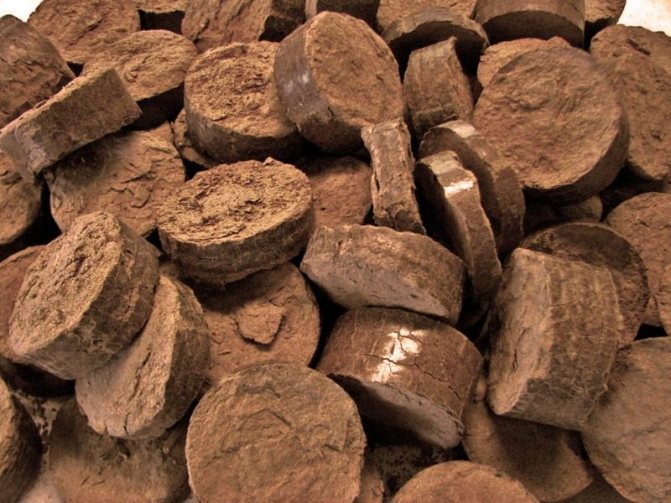

Pressed peat or wooden Euro briquettes. Fuel briquettes made on the basis of peat have a small area, while they are capable of smoldering for a long time, maintaining the phase of active combustion.
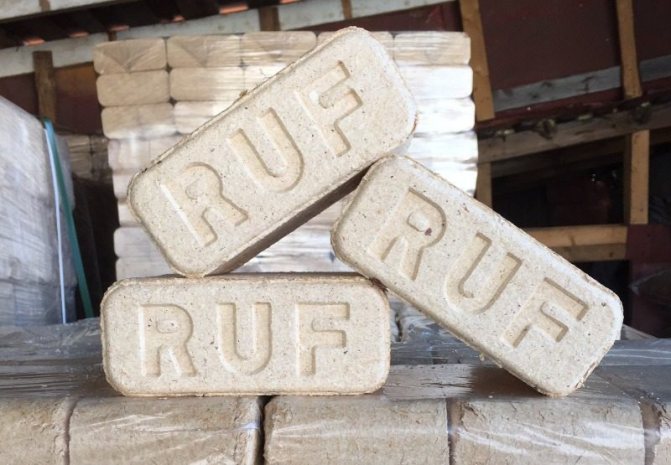

Pellets. It is a biofuel made in the form of pellets. For the production of peat, wood and agricultural waste are used. It is an environmentally friendly and energy efficient material that is preferable to use in boilers, the design of which is adapted to pellets.


How to choose
Advantages of long-burning steel boilers:
- one-piece welded construction that is not subject to leaks;
- fast heating and cooling of the walls of the boiler and heat exchanger;
- full automation is possible due to low inertia;
- less weight;
- reasonable price.
Disadvantages of steel models:
- susceptibility to corrosion, especially in welding areas;
- steel boilers cannot be repaired; in case of perforating corrosion and leaks, the unit is replaced with a new one.
The advantages of long-burning cast iron boilers include:
- resistance of cast iron to corrosion;
- the design of the heat exchanger from separate sections allows for partial replacement in case of damage;
- cast iron is a brittle and non-plastic material, in the event of a sharp change in temperature, cracks and destruction are possible;
- higher price than steel models;
- cast iron boilers are much heavier - 1.5-2.5 times.
Loading volume and automation The frequency of filling the combustion chamber with coal depends on this characteristic. It is worth analyzing whether it will be convenient to load coal several times a day, or whether it is better to give preference to models with a large load volume. They occupy a small area, while their loading chamber is quite large, and some models can heat a house on one load for 5 days on anthracite and 3 days on brown coal. Mine boilers are usually equipped with microcontrollers to automate the entire process and keep maintenance to a minimum. Bottom loading boilers are usually smaller, much cheaper than mine boilers and easier to handle. Such boilers usually do not have a blower fan, and the air intake is due to the draft. The chimney for such a boiler should be as simple as possible and have a total length of no more than 5 meters. The advantages of boilers without traction are independence from electricity and a low price. Cons - a low level of automation. The least attention and maintenance are required for fully automated models with a loading bunker that can hold a multi-day rate of fuel. Their price, of course, is high, but they have a number of advantages that provide worry-free heating during the season:
- fuel feed mechanism equipped with a turner;
- built-in and remote sensors that control the combustion process;
- emergency valves to prevent boiling;
- SMS alarm mode;
- function of maintaining combustion and standby mode;
- DHW circuit.
Boiler maintenance is reduced to loading the bunker at the beginning of the season and setting the parameters of the required mode.
Video: automated boiler with a hopper
The choice and purchase of a boiler is not an easy matter, and given the cost of modern models, it is also costly. Therefore, for small private or country houses, you can evaluate your strength and make a coal stove with your own hands.
Device
A do-it-yourself coal stove includes the following elements:
- blew;
- firebox;
- chamber for additional drying of fuel;
- chimney.
The design of the firebox and chimney differs from analogs operating on wood. The firebox has two compartments. Firewood is fired in one compartment, coal is dried in the other. As soon as the temperature is sufficient, the coal also starts to burn. This is due to the fact that coal has a rather high ignition temperature and it simply will not work to ignite the furnace in a standard way.
A combined firebox is often used, which can work both on wood and coal. This option is the most rational for a charcoal stove for heating a house.
Coal stoves for home heating can be characterized by the following indicators:
- By appointment. The coal stove can be used not only for heating, but also perform additional functions. This parameter can be distinguished:
- Heating stoves. Coal is an efficient fuel. Such coal-fired stoves, especially made of bricks, are much more powerful than their wood-fired counterparts.They are able to provide heat to the entire house, and not 1-2 rooms. Such an oven is large in size and weight. In the manufacture, materials with increased strength characteristics and maximum heat resistance are used. Such a heater requires a solid foundation on a perfectly flat base.
- Fireplace stoves. The coal-fired stove is able not only to reliably protect the room from the cold, but also performs a decorative function. Such ovens are required to have an attractive appearance and often become a central design element. The main attention is paid to the correct selection of materials for finishing. It must meet several parameters: be environmentally friendly, retain heat well, protect against injury, and have an attractive appearance. Most often, natural stone is used for decoration.
- Stoves with a hob. They have an additional hob that allows you to cook food. The dishes for this must be thick enough to withstand the heat. Cast iron is ideal. This dish will never burn out and the food cooked in it has a special taste. This material is also suitable for the manufacture of a hob, but it has a big drawback. Cast iron is very brittle and cracks easily. Therefore, you have to be extremely careful when operating. Alloy steel is also used for the hob. This material is not afraid of temperature extremes and is very durable. Use it more efficiently.
- Stoves for household needs. It is a furnace with a heat exchanger. This option will not only save you from the cold, but also provide hot water that can be used for household needs. You can arrange a warm floor system. This will allow the room to warm up more evenly.
- By the type of material used.For a furnace that runs on coal, you need to use a material with increased resistance to high temperatures. Experts recommend making a stove from the following materials:
- Brick —is the most common material for making ovens. Its advantages lie in its high heat capacity - the material is able to accumulate heat and give it off evenly for a long time. The disadvantages are also obvious: the large mass of the structure and the laboriousness of manufacture. In terms of financial costs, it is the most economical option.
- Steel —has become frequently used recently. The material is quite strong and durable. It is used for the manufacture of factory products. It is better to make a steel stove for coal with your own hands. The complexity of the work is much lower than in the manufacture of a brick analogue. The room heats up faster, but there is a significant disadvantage. Steel, unlike a coal-fired brick oven, is not able to retain heat. As soon as the fuel runs out, it instantly cools down.
- Cast iron —cast iron is intermediate between steel and brick. The weight of such a furnace should be significantly greater than that of a steel one. It will heat up and cool down faster than brick. With careful operation, such a structure will serve for several decades. It is quite problematic to make such a stove on your own. A factory analog will not be cheap.
- Talcomagnesite. The material has excellent thermal conductivity - ten times higher than that of bricks. And this despite the fact that its ability to store heat is only 44% worse. What does this mean in practice? Such a stove will heat up almost as quickly as a metal stove, but it will give off enough heat to not add fuel overnight. This material is also not without its drawbacks. Such a heating stove will be heavier than a brick one with the same dimensions and is not cheap.
- Combined. It is impossible to find an ideal material for a heating stove. As you can see above, each material has its own pros and cons.What if you take their strengths and combine them with each other. The strengths of one material can successfully neutralize the weaknesses of another. This technique has been used for a long time. A cast iron boiler can be faced with talc magnesite (another name for the mineral is talcum chloride or stove stone) and add a water heating circuit.
- By the method of fuel combustion.Separate furnaces with a conventional firebox and devices with an implemented function of long-term combustion, which are capable of operating up to 3 times longer on the same fuel load.
Preparatory stage for kindling the furnace
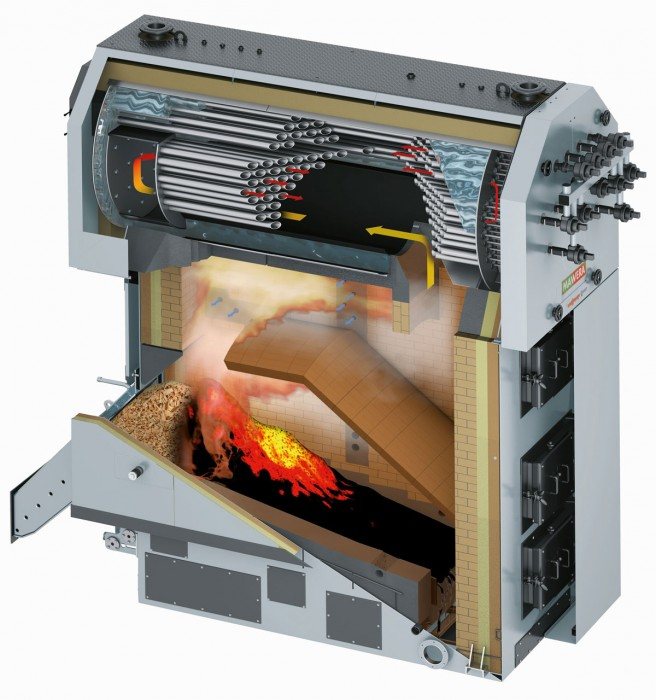

If you are going to start kindling the furnace of a furnace that has not been used for a long time, a number of preparatory measures should be taken. This procedure must be carried out in order to ensure the trouble-free operation of the furnace, as well as to avoid unpleasant situations that sometimes lead to fires or harm to human health and life.
• Inspect for cracks. Their presence can contribute to the penetration of smoke and even carbon monoxide into the room. If any are found, minor repairs should be carried out immediately using a mixture of clay and sand. • Clean out soot from all gas ducts and chimney. Wipe off dust from the inner walls with a dry cloth, so as not to feel a bad aroma when kindling. In general, it is advisable to perform this procedure 2-3 times a month.
• Pay attention to the doors, especially to their fit, the functionality of the locking mechanisms, in order to avoid the appearance of smoke. • Select fuel of the proper quality, suitable for your particular type of stove
• Properly equip solid fuel storage areas.
During further operation, you should also follow a number of simple rules. The use of plastic, construction and household waste for kindling will lead to severe contamination of the stove. It is wrong to open the blower and the oven door at the same time. It should be heated several times a day for one and a half to two hours to avoid overheating. Dry, medium-sized, dust-free charcoal will provide excellent functionality.
Avoid storing flammable objects near hot walls. Do not leave the stove unattended during kindling, especially in houses where there are children.
Recommendations and the process of igniting the furnace
The coal stove is fired a couple of times a day. The duration of combustion of raw materials in the furnace should not be more than two hours. It is recommended to load dry medium-fraction coal.
In order to efficiently and safely heat the premises with the help of coal, the furnace should be kindled correctly. This should be done in stages:
- Initially, dry sheets of paper are laid on the bottom of the combustion chamber, on which small wooden chips are laid out on top.
- Well-dried firewood is laid on top of the chipped pieces of wood. It is good to use birch logs for ignition.
- After placing all the necessary materials for kindling, the paper is ignited. Immediately after this, open the blower and close the firebox door. The combustion rate of wood depends on the presence of air masses. It is recommended to fire up with an open ash pan, as this creates a natural air flow that will allow the chimney to warm up.
- When the logs burn out, and ash remains smoldering in their place, you can make the first filling of fuel. For this, fine coal is used, which is easily ignited by hot wood residues. The bookmark layer should be fifteen centimeters.
- When the draft increases during combustion, the ash compartment must be closed and the fan must be activated.
